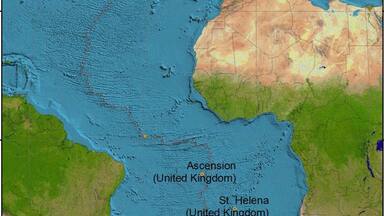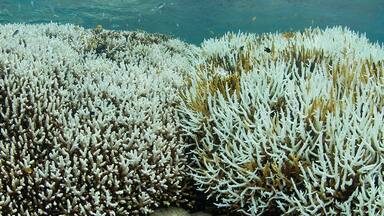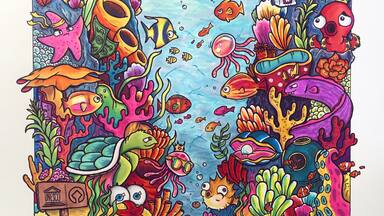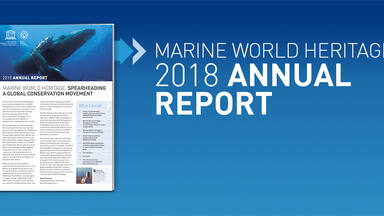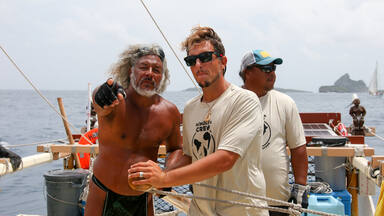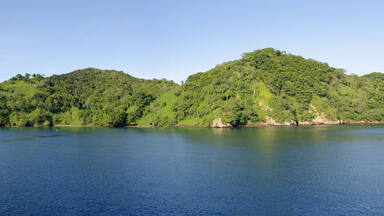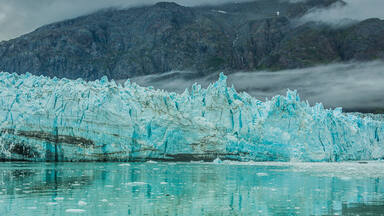Brazilian Atlantic Islands: Fernando de Noronha and Atol das Rocas Reserves
Brazilian Atlantic Islands: Fernando de Noronha and Atol das Rocas Reserves
Peaks of the Southern Atlantic submarine ridge form the Fernando de Noronha Archipelago and Rocas Atoll off the coast of Brazil. They represent a large proportion of the island surface of the South Atlantic and their rich waters are extremely important for the breeding and feeding of tuna, shark, turtle and marine mammals. The islands are home to the largest concentration of tropical seabirds in the Western Atlantic. Baia de Golfinhos has an exceptional population of resident dolphin and at low tide the Rocas Atoll provides a spectacular seascape of lagoons and tidal pools teeming with fish.
Description is available under license CC-BY-SA IGO 3.0
Îles atlantiques brésiliennes : les Réserves de Fernando de Noronha et de l'atol das Rocas
Les sommets de la dorsale sous-marine de l’Atlantique Sud forment l’archipel de Fernando de Noronha et l’atoll das Rocas, au large des côtes brésiliennes. Ils représentent une grande partie de la superficie insulaire de l’Atlantique Sud et leurs eaux fécondes constituent des lieux de reproduction et de subsistance extrêmement importants pour les thons, requins, tortues et mammifères marins. Ces îles abritent la plus grande concentration d’oiseaux marins tropicaux de l’océan Atlantique Ouest. La baie de Golfinhos accueille une population exceptionnelle de dauphins résidents et, à marée basse, l’atoll das Rocas offre un paysage spectaculaire de lagons et de bassins de marée grouillants de poissons.
Description is available under license CC-BY-SA IGO 3.0
الجزر الأطلسية البرازيلية: محميّات فرناندو دو نورونيا وجزيرة داس روكاس المرجانية
يتألف أرخبيل فرناندو دو نورونيا وجزيرة داس روكاس المرجانية، قبالة السواحل البرازيلية، من قمم المرتفعات المغمورة بالمياه في المحيط الأطلسي الجنوبي. ويشكّل هذان الموقعان قسماً كبيراً من المساحة الجزرية في المحيط الأطلسي الجنوبي وتمثّل مياههما الغنية أماكن مؤائية لتكاثر وبقاء أسماك التنّة والقروش والسلاحف والثديات البحرية. كما تأوي هذه الجزر أكبر تجمع لأسراب الطيور البحرية الإستوائية في المحيط الأطلسي الغربي. أمّا خليج غولفينيوس، فهو مرتع لفصيلة إستثنائية من الدلافين المستوطنة وفي أقصى الجَزَر، تقدّم جزيرة داس روكاس المرجانية منظراً طبيعياً خلاباً مؤلفاً من البحيرات المرجانية وأحواض برك المد والجزر التي تعجّ بالأسماك.
source: UNESCO/CPE
Description is available under license CC-BY-SA IGO 3.0
巴西大西洋群岛:费尔南多-迪诺罗尼亚群岛和罗卡斯岛保护区
南大西洋露出海面的海底山脉形成了费尔南多-迪诺罗尼亚群岛和巴西沿海的罗卡环形礁。这个区域包括了南大西洋大部分岛屿,对于鲔鱼、鲨鱼、海龟和海洋哺乳动物的生长和繁衍具有重要意义。巴西大西洋群岛也是西大西洋上热带海鸟最集中的地方。在拜亚海区生活有大量海豚,在落潮期,罗卡环形礁给游客展示出一幅怡人的海岸美景,泻湖和潮水坑星罗棋布,里面还有各种鱼类。
source: UNESCO/CPE
Description is available under license CC-BY-SA IGO 3.0
Бразильские острова в Атлантике: Фернанду-ди-Норонья и атолл Рокас
Архипелаг Фернанду-ди-Норонья и атолл Рокас, которые представляют собой выходящие на поверхность океана вершины подводного Южно-Атлантического хребта, лежат у восточных берегов Бразилии. Эти острова – одни из крупнейших в этом районе Атлантики, а их прибрежные воды отличаются высокой биопродуктивностью и играют исключительную роль в качестве мест обитания и размножения тунца, акул, морских черепах и морских млекопитающих. На островах отмечены самые крупные в Западной Атлантике скопления морских тропических птиц; также здесь сложилась большая местная популяция дельфинов. Во время отливов на атолле Рокас можно наблюдать впечатляющую картину: обмелевшие лагуны, кишащие рыбой.
source: UNESCO/CPE
Description is available under license CC-BY-SA IGO 3.0
Islas atlánticas brasileñas – Reservas de Fernando de Noronha y Atolón de las Rocas
Cimas de la gran dorsal submarina del Atlántico Sur que emerge frente a las costas de Brasil, el archipiélago de Fernando de Noronha y el Atolón de las Rocas representan una gran parte de la superficie insular de la región. Debido a sus aguas ricas en nutrientes, el sitio es de suma importancia para la alimentación y reproducción de atunes, tiburones, tortugas de mar y mamíferos marinos. Estas islas albergan la mayor concentración de aves marinas tropicales del Atlántico Occidental. La bahía de los Golfinhos es famosa por su excepcional población de delfines y, durante la marea baja, el Atolón de las Rocas ofrece un espectacular paisaje, salpicado de lagunas y pozas repletas de peces.
source: UNESCO/CPE
Description is available under license CC-BY-SA IGO 3.0
ブラジルの大西洋諸島:フェルナンド・デ・ノローニャとロカス環礁保護区群
source: NFUAJ
Braziliaanse Atlantische eilanden Fernando de Noronha en het reservaat Atol das Rocas
Source: unesco.nl
Outstanding Universal Value
Brief description
Of indescribable beauty, the Fernando de Noronha Marine National Park, located at a distance of about 340 km off the Brazilian coast, is formed by volcanic peaks of a submerged mountain chain. Nearly 70% of the main island of Fernando de Noronha, 21 smaller islands and islets of the archipelago, as well as most adjacent waters to a depth of 50 metres are part of the property. The Atol das Rocas Biological Reserve, the only atoll in the South Atlantic, is located about 150 km west of Fernando de Noronha. It is an elliptical reef including two small islands surrounded by a marine reserve. With these two protected areas, the property covers an area of 42,270 ha and a buffer zone of 140,713 ha.
At the heart of a vast ocean surface, the Brazilian Atlantic Islands form an oasis of fertile waters, which are extremely important breeding and living places for tuna, shark, turtle and marine mammals, and which play a crucial role in the natural fish restocking of the region. Two species of sea turtle breed there: the hawksbill and green turtle, for which the Rocas Atoll is considered the second most important breeding site of Brazil. These islands are home to the largest concentration of tropical seabirds in the Western Atlantic, and include the only examples of Insular Atlantic Forest and the only oceanic mangrove in the South Atlantic. Dolphin Bay (Baía dos Golfinhos) hosts an exceptional population of resident dolphin, and at low tide, Rocas Atoll provides a spectacular seascape of lagoons and tidal pools teeming with fish and a great variety of shellfish, sponges, molluscs, corals, etc.
Criterion (vii): Dolphin Bay is the only known place in the world with such a large population of resident dolphins. In addition, two of its beaches, Praia do Sancho and Praia do Leão, were elected as the most beautiful in Brazil. The Rocas Atoll has a spectacular seascape, especially at low tide when the exposed reef surrounding shallow lagoons and tidal pools forms a natural aquarium. Both sites also have exceptional underwater landscapes that have been recognised worldwide in specialized diving literature.
Criterion (ix): The Fernando de Noronha and Atol das Rocas represents over half the insular coastal waters of the Southern Atlantic Ocean. These highly productive waters provide feeding ground for species such as tuna, billfish, cetaceans, sharks and marine turtles as they migrate to the African coast. An oasis of marine life in relatively barren, open ocean, the islands play a key role in the process of reproduction, dispersal and colonization by marine organisms in the entire Tropical South Atlantic.
Criterion (x): The Fernando de Noronha and Rocas Atoll are key sites for the protection of biodiversity and endangered species in the Southern Atlantic. Providing a large proportion of the insular habitat of the South Atlantic, the site is essential for the maintenance of marine biodiversity. It is important for the conservation of threatened species of marine turtles, particularly the hawksbill turtle. The site accommodates the largest concentration of tropical seabirds to be found in the Western Atlantic Ocean and is a Global Centre of Bird Endemism. The site also contains the only remaining sample of the Insular Atlantic Forest and the only oceanic mangrove in the South Atlantic region.
Integrity
The terrestrial and marine components of the site are well protected. The boundaries of the site are appropriate for the conservation of the marine biological diversity, even if the property is divided into two separate components. On the main island of Fernando de Noronha all the key terrestrial habitats are part of the Park and all land areas of the Rocas Atoll are located in the central zone of the protected area.
At Fernando de Noronha, the ecosystem retains great integrity, despite the growing number of visitors to the island and the impacts generated by the presence of invasive alien species. The infrastructure and management have been improved to ensure better conservation of the values of this site.
Although the level of preservation of the ecosystems of the Rocas Atoll remains high, overfishing and the illegal presence of tourist boats are the main threats to the integrity of the site.
Protection and management requirements
The property has adequate legal protection conferred by a number of federal laws and state regulations. The Chico Mendes Institute for Biodiversity Conservation (ICMBio), an autonomous federal agency under the Ministry of Environment, is responsible for the management and conservation of the site. The site has two separate management plans, one for Fernando de Noronha and the other for Rocas Atoll. These management plans address issues such as tourism, research, environmental education, protection and monitoring of the biodiversity. For the Fernando de Noronha Marine National Park, a Sustainable Development and Ecotourism Management Plan was implemented with the support of local people. It strictly controls the development of tourism infrastructure and visits, and also covers the urbanized areas located outside the property. This plan takes into account the carrying capacity of different areas within the park and regulates navigation and diving.
Some of the main threats are related to fishing, their implications for fish populations and their composition in terms of species in the Reserve, as well as their effect on sea turtles and other species. A new approach involving the regulation of fishing in the area surrounding the property may be required. Since Fernando de Noronha was completely deforested (while the island was used as a prison, then as a military base), vegetation is now either secondary or composed of invasive species. The introduction of rats, mice, dogs, and even tegus (a lizard) has had dramatic effects on birds. The restoration of the original vegetation and eradication of invasive species should be an urgent priority for this globally important site. Good management of the increasing tourism in this fragile environment is also very important.
Founded in 1979, the Atol das Rocas Biological Reserve is banned from public access and managed for the protection of species and for research. The underwater links between the two components would merit study. The Reserve benefits from surveillance by the Brazilian Navy and the Air Force, notably as concerns fishing and tourism activities.
To provide financial support and strengthen local wildlife management, the ICMBio developed two projects: the Tamar Project, for marine turtles and the Spinner Dolphin Project.
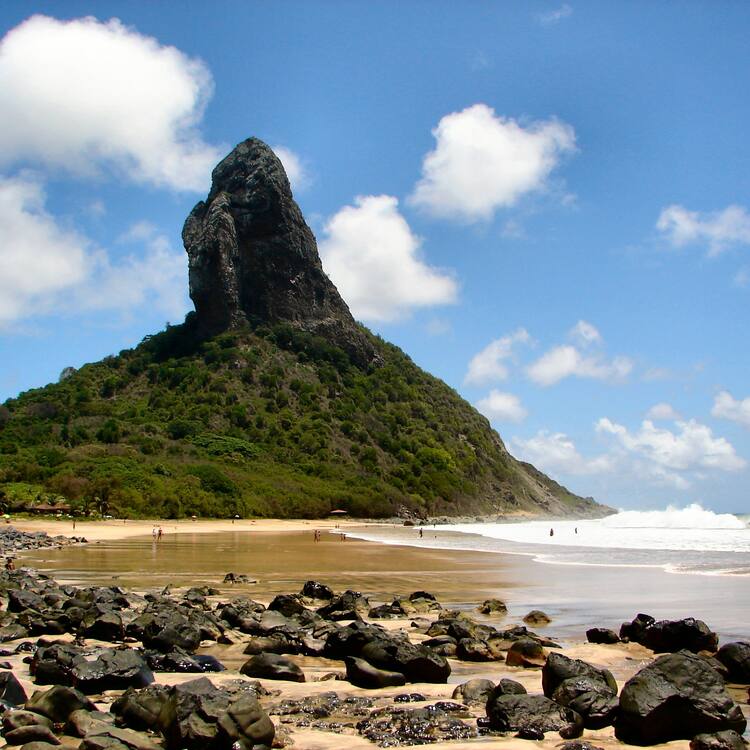
 View photos from OUR PLACE the World Heritage collection
View photos from OUR PLACE the World Heritage collection
